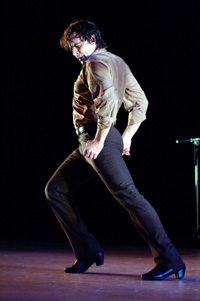
A Fuego Lento Photo by Miguel Angel Gonzalez
There are few folk dances that blend passion and precision, energy and elegance, as well as flamenco.
Its origins are only dimly known, and there is debate over the very word. The dance appeared first in the Andalusian region of Spain in the sixteenth century during what is known as the Reconquest and quickly spread. The unique mélange of native Andalusian, Islamic, Sephardic, and Gypsy cultures, gives the dance its themes of loss, persecution, pride, as well as its characteristic rite of sexual tension.

Maria Jose Franco Photo by Dean Thomas
The word flamenco might mean gypsy or perhaps a reference to the Flemish, the legendary home of the gypsies. In either case, the origins are distinctly folk oriented, the dance developing from the poorer strata of society. Over the past 500 years it has been alternately derided as an uncouth regional dance and hailed as the pinnacle of Iberian soul.Now we have a unique opportunity to appreciate the very best in flamenco dance with the New World Flamenco Festival August 10-19 at the Irvine Barclay Theatre. The festival is titled La Flor de la Vida, The Prime of Life, and premieres three companies of young flamenco dancers who are among the very best currently performing in Spain.This established festival has often emphasized the stars of traditional flamenco, but this year’s program will bring a new generation to Southern California.

Juan Ogalla Photo by Andy Mogg
This is an unprecedented chance to see what is new and coming inflamenco dance. All the troupes are in the prime of life and promise to present an exciting show of new works, some created especially for this festival.Each company is led by a well-known dancer who has built his or her own company and been successful at Spain’s major flamenco festival, Festival de Jerez. The three troupes will divide the ten day festival.Compañia Maria José Franco will perform August 10-12, a program titled De Grana y Oro, and features, besides Ms. Franco, a high-profile cast including Morenito de Llora, Juan Jose Amador and Luis Moneo. August 14-15, André Peña and Pila Ogalla will present “A Fuego Lento,” which promises a smoldering male and female duet. And Compañia Juan Ogalla, with guest artist Milagros Mengibar, will perform Cosas de Cai, August 17-19, featuring Spain’s leading exponent of the bata de cola, the long gown.
This is a chance to enjoy some of the best dancers in the world of any style, and a festival that deserves to attract many people interested in, and appreciative of, great folk dancing, fabulous production, and sensual storytelling.
















